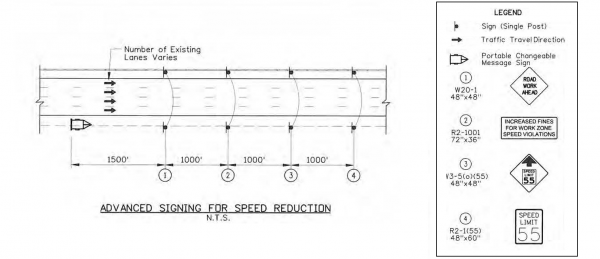The Idaho Transportation Department has received interest regarding the traffic control plan for the Five Mile to Orchard project on Interstate 84. You can see the entire traffic control plan for project by clicking here.
ITD Construction projects that have shoulder or lane restrictions are required to include a traffic control plan that meet the standards included in the federal and state approved Manual on Uniform Traffic Control Devices (MUTCD). These contractor traffic control plans are used to set up signs, barrels, and other traffic control devices for a project.
Below is a brief description of the traffic control plan:
First, the plans for advance warning signs before the lane reduction. This information can be found on page 14 of the traffic control plan.

The first sign a motorist would encounter is a portable changeable message sign on the right shoulder. This sign read “NIGHT WORK THRU JUNE: CHECK 511.” This sign was placed on the east side of the Eagle Road Overpass.
A minimum of 1,500 feet after the portable changeable message sign, the plan calls for a 4’x4’ orange diamond signs on both shoulders that read “ROAD WORK AHEAD.”
A minimum of 1,000 feet after the “ROAD WORK AHEAD” sign the plan calls for a 6’x3’ white rectangular signs on both shoulders that read “INCREASED FINES FOR WORK ZONE SPEED VIOLATIONS.” Following these signs, a minimum of 1000’ away 4’x4’ orange diamond signs on each shoulder are placed with a “SPEED LIMIT 55” box and arrow pointing up indicating a speed limit reduction ahead.
A minimum of 1,000’ feet beyond these orange diamond sign, the plan calls for 4’x5’ white and black rectangular signs on both shoulders reading “SPEED LIMIT 55.” At this point, drivers have seen four signs on each shoulder over a minimum of 4,500 feet. All of this signage is placed before the lane restriction begins.
The next section ITD highlights is the beginning of the construction zone. This information can be found on page 12 of the traffic control plan.

A minimum of 1,000 feet after the “SPEED LIMIT 55” signs discussed above, the plan calls for 4’x4’ orange diamond signs on both shoulders indicating the number of lanes closed ahead. This project closed the three left lanes and the signs at this location on the field read “3 LANES CLOSED AHEAD.”
A minimum of 1,500 feet after these signs, the plan calls for 4’x4’ orange diamond signs on both shoulders indicating the left lane is closing ahead (sign 8 in the figure above). A minimum of 1,000’ after this sign, the taper to close off the lane begins.
The plan allows for two options on how to execute a taper. One option is to have a continuous taper closing all three lanes over 1,980 feet. The second is to have three separate tapers, with a tangent (straight) section between each taper.
The plan for this option is detailed as follows. At the beginning of each taper, an illuminated merge right arrow sign is placed. Orange drums with retroreflective lines are used for each taper and tangent section, spaced no more than 55 feet apart.
Each taper must extend a minimum of 660 feet. At the end of each taper, a minimum straight segment (identified as tangent on the plan sheets) of 1,320 feet (1/4 mile) extends until the beginning of the next taper.
Overall, from the first notice of construction at the portable changeable message sign to the final single lane of travel, a vehicle traveling the maximum legal speed would have more than two minutes and twenty seconds to make the appropriate maneuvers and be in the proper lane.

